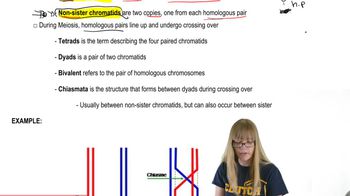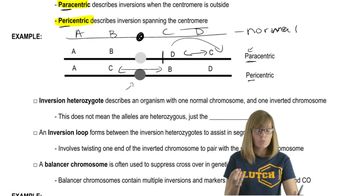A person has a WT chromosome with the following segments. A B C • D E F G H. Which of the following shows how the chromosome would look after an paracentric inversion?
Table of contents
- 1. Introduction to Genetics51m
- 2. Mendel's Laws of Inheritance3h 37m
- 3. Extensions to Mendelian Inheritance2h 41m
- 4. Genetic Mapping and Linkage2h 28m
- 5. Genetics of Bacteria and Viruses1h 21m
- 6. Chromosomal Variation1h 48m
- 7. DNA and Chromosome Structure56m
- 8. DNA Replication1h 10m
- 9. Mitosis and Meiosis1h 34m
- 10. Transcription1h 0m
- 11. Translation58m
- 12. Gene Regulation in Prokaryotes1h 19m
- 13. Gene Regulation in Eukaryotes44m
- 14. Genetic Control of Development44m
- 15. Genomes and Genomics1h 50m
- 16. Transposable Elements47m
- 17. Mutation, Repair, and Recombination1h 6m
- 18. Molecular Genetic Tools19m
- 19. Cancer Genetics29m
- 20. Quantitative Genetics1h 26m
- 21. Population Genetics50m
- 22. Evolutionary Genetics29m
6. Chromosomal Variation
Chromosomal Rearrangements: Inversions
Problem 11
Textbook Question
Contrast the genetic composition of gametes derived from tetrads of inversion heterozygotes where crossing over occurs within a paracentric versus a pericentric inversion.
 Verified step by step guidance
Verified step by step guidance1
Step 1: Understand the difference between paracentric and pericentric inversions. A paracentric inversion occurs when the inverted segment does not include the centromere, while a pericentric inversion includes the centromere within the inverted segment.
Step 2: Analyze the image provided. The illustration shows a chromosomal inversion where segments of the chromosome are rearranged. In the case of crossing over within a paracentric inversion, the resulting gametes may include acentric fragments (lacking a centromere) and dicentric chromosomes (with two centromeres), which are often non-viable.
Step 3: For crossing over within a pericentric inversion, the inversion includes the centromere. The recombination results in gametes with duplications and deletions of genetic material, but these gametes retain centromeres, making them potentially viable but genetically imbalanced.
Step 4: Compare the genetic composition of gametes. In paracentric inversions, crossing over leads to structural abnormalities (acentric and dicentric chromosomes), whereas in pericentric inversions, crossing over results in genetic imbalances due to duplications and deletions.
Step 5: Conclude that the type of inversion (paracentric vs. pericentric) significantly impacts the viability and genetic composition of gametes derived from crossing over events within inversion heterozygotes.
 Verified video answer for a similar problem:
Verified video answer for a similar problem:This video solution was recommended by our tutors as helpful for the problem above
Video duration:
1mPlay a video:
Was this helpful?
Key Concepts
Here are the essential concepts you must grasp in order to answer the question correctly.
Tetrads and Crossing Over
Tetrads are structures formed during meiosis when homologous chromosomes pair up. Crossing over occurs when segments of DNA are exchanged between these paired chromosomes, leading to genetic recombination. This process increases genetic diversity in gametes, which is crucial for evolution and adaptation.
Recommended video:
Guided course

Crossing Over Terminology
Paracentric Inversion
Paracentric inversion is a chromosomal rearrangement where a segment of a chromosome is inverted, but the inversion does not include the centromere. When crossing over occurs in paracentric inversions, it can lead to the formation of acentric fragments, which can result in gametes with missing genetic information, affecting viability.
Recommended video:
Guided course

Inversions
Pericentric Inversion
Pericentric inversion involves the inversion of a chromosome segment that includes the centromere. During crossing over in pericentric inversions, the resulting gametes can have duplications and deletions of genetic material. This can lead to viable but genetically unbalanced offspring, impacting traits and fitness.
Recommended video:
Guided course

Inversions
Related Videos
Related Practice
Multiple Choice
553
views
1
rank


